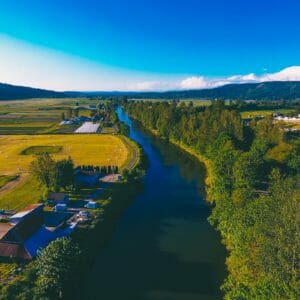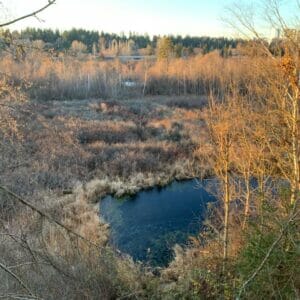Introduction:
King County, located in Washington State, is home to over 2 million people, making it the state’s most populous county. If you’re seeking ecological consulting services here, it’s crucial to check the qualifications and experience of the consultants you’re considering, ensuring they have the right expertise for your project needs. Ecological consulting involves providing scientific and technical advice on the natural environment and its resources to various clients, including government agencies, businesses, nonprofits, and landowners. At Eastside Environmental Pros, we specialize in projects within King County jurisdiction.
Our Services:
- Wetland & Stream Delineation
- Environmental Permitting
- Environmental Planning
- Land Use and Regulatory Guidance
- Mitigation Planning & Design
What is Wetland & Stream Delineation?
Wetland and stream delineation is the process of identifying and mapping the boundaries of wetlands and streams. This is typically done by trained professionals, such as wetland scientists or ecologists, who use a combination of field observations, soil and vegetation analysis, and hydrological data to determine the boundaries of these areas.
Wetland and stream delineation is important for a variety of reasons. Wetlands and streams provide many important ecological functions, such as water filtration, flood control, and habitat for a variety of plants and animals. Therefore, it is important to accurately identify and map these areas to ensure their protection and proper management.
Wetland and stream delineation is also often required by regulatory agencies as part of the permitting process for development or land use activities. For example, if a developer wants to build on a piece of land that contains a wetland, they may be required to obtain a wetland permit from the appropriate regulatory agency. This permit will often require the developer to hire a wetland scientist or ecologist to conduct a wetland delineation to determine the boundaries of the wetland on the property.
Wetland and stream delineation can be a complex process that requires a thorough understanding of the local geology, hydrology, and ecology of the area. It is important to choose a trained and experienced professional to conduct this work to ensure accurate and reliable results.
What is Environmental Permitting ?
Environmental permitting is the process of obtaining permission from regulatory agencies to conduct activities that have the potential to impact the environment. Environmental permits are typically required for activities such as construction, development, land use changes, and resource extraction.
The specific requirements for obtaining an environmental permit vary depending on the type of activity being proposed and the location of the project. In the United States, environmental permitting is typically regulated at the federal, state, and local levels.
Some of the common types of environmental permits that may be required include:
-
- Air permits: These permits are required for activities that have the potential to emit air pollutants.
- Water permits: These permits are required for activities that may impact the quality or quantity of surface or ground water, such as discharge of wastewater or withdrawal of large amounts of water.
- Wetland permits: These permits are required for activities that may impact wetlands, such as filling or draining a wetland or building within a wetland.
- Endangered species permits: These permits are required for activities that may impact endangered or threatened species or their habitats.
- Hazardous waste permits: These permits are required for the storage, treatment, or disposal of hazardous waste.
Obtaining an environmental permit can be a complex process that involves submitting a permit application, conducting environmental studies and assessments, and working with regulatory agencies to ensure compliance with relevant laws and regulations. It is important to carefully review the permitting requirements for your project and to work with experienced professionals to ensure a smooth and successful permitting process.
What is Environmental Planning?
Environmental planning is the process of identifying, analyzing, and mitigating the potential environmental impacts of land use and development activities. Environmental planning typically involves the integration of environmental considerations into the planning and decision-making process for projects such as land use development, transportation, and resource management.
Environmental planning is important because it helps to ensure that development and land use activities are carried out in a way that is sustainable and minimizes negative impacts on the environment. Environmental planning can also help to protect natural resources, such as water and air quality, and preserve important ecological areas.
There are several key elements to environmental planning, including:
- Environmental assessment: This involves identifying and analyzing the potential environmental impacts of a project or land use activity.
- Environmental impact assessment (EIA): This is a formal process for evaluating the potential environmental impacts of a project or land use activity. EIAs are typically required by regulatory agencies for large or complex projects.
- Environmental management: This involves implementing strategies and actions to mitigate or offset the negative environmental impacts of a project or land use activity.
- Environmental regulation: This involves the development and enforcement of laws and regulations that aim to protect the environment.
Environmental planning is a complex process that requires a comprehensive understanding of the environmental and social impacts of land use and development activities. It is important to involve experienced professionals in the environmental planning process to ensure that the potential impacts of a project are thoroughly analyzed and mitigated.
What is Land Use and Regulatory Guidance?
Land use and regulatory guidance refers to the rules, regulations, and policies that govern how land can be used and developed. These guidelines are typically established by government agencies at the local, state, or federal level, and may include zoning laws, building codes, and environmental regulations.
Land use and regulatory guidance is important because it helps to ensure that land is used in a way that is consistent with the needs and values of the community. It can also help to protect the environment and natural resources, and to prevent conflicts between different land uses.
There are several types of land use and regulatory guidance that may be applicable to a particular project, depending on the location and nature of the project. Some examples include:
- Zoning laws: These laws regulate the use of land in a particular area, and may specify the types of activities that are permitted in different areas (e.g., residential, commercial, industrial).
- Building codes: These codes establish standards for the design and construction of buildings, and may include requirements for things like building materials, structural integrity, and energy efficiency.
- Environmental regulations: These regulations are designed to protect the environment and natural resources, and may include requirements for things like air and water quality, hazardous waste management, and endangered species protection.
- Land use policies: These policies are developed by government agencies or other organizations to guide land use and development decisions in a particular area.
It is important to carefully review the relevant land use and regulatory guidance for your project to ensure compliance with all applicable laws and regulations. Working with experienced professionals, such as land use planners or attorneys, can help to ensure that you are aware of all applicable guidelines and can navigate the permitting process smoothly.
What is Mitigation Planning & Design?
Mitigation planning and design is the process of identifying and implementing strategies to mitigate or offset the negative impacts of development or land use activities on the environment. Mitigation measures are typically designed to restore, enhance, or protect natural resources that may be impacted by the project.
Mitigation planning and design is often required as part of the environmental permitting process for development or land use activities. Regulatory agencies may require that a developer or landowner implement mitigation measures to compensate for any negative impacts of the project on the environment.
There are several types of mitigation measures that may be implemented as part of a mitigation plan, including:
- Habitat restoration: This involves restoring or enhancing habitat areas that may have been impacted by the project, such as wetlands, streams, or forests.
- Habitat creation: This involves creating new habitat areas to compensate for habitat loss caused by the project.
- Habitat protection: This involves measures to protect existing habitat areas from future impacts.
- Resource replacement: This involves replacing or providing compensation for natural resources that may have been lost or degraded due to the project.
- Resource conservation: This involves measures to conserve and protect natural resources, such as water, air, and soil quality.
Mitigation planning and design is a complex process that requires a thorough understanding of the environmental impacts of the project and the potential mitigation measures that may be appropriate. It is important to work with experienced professionals, such as ecologists or environmental engineers, to ensure that an effective and appropriate mitigation plan is developed and implemented.






